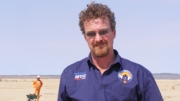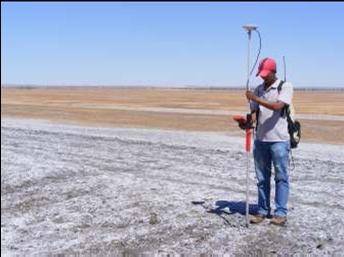
While Hakskeen Pan offers a fantastic surface for BLOODHOUND SSC to run on, there is a huge amount of preparation work to be done – and it’s already started. Our ‘Track Boss’, Rudi Riek, describes the first test clearance and gives us an idea of the work left to do.
by Rudi Riek
 Having just completed the very successful hosting of the 2010 FIFA World cup in our country, I thought it apt to give you soccer fans out there a comparison that might just frighten you.
Having just completed the very successful hosting of the 2010 FIFA World cup in our country, I thought it apt to give you soccer fans out there a comparison that might just frighten you.
In preparing the track and safety zones at Hakskeenpan for BLOODHOUND’s record attempt in 2012 we will be clearing the equivalent of 4,800 soccer pitches of stones and various other obstructions.
The figures are quite daunting when you look at them and dealing with millions of square metres is commonplace when attempting a project like this. I may be wrong, but I do believe nothing of this scale has ever been attempted. To give a sense of the size of the task, we have to clear a total of 24 000 000 sq m (yes, twenty-four million) – that’s the equivalent of clearing a standard 2-lane road from London to Moscow, or a 4-lane motorway from Cape Town to Johannesburg.
While the size of the task is huge, it pales in comparison to the work that would be needed on other pans like it in our country. While there are other pans across the world, the unique surface quality and the great weather in the Northern Cape make this the best place for BLOODHOUND to run, so we’ve got to get on with it.
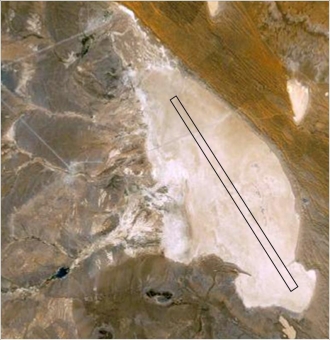 Let us start by telling you what BLOODHOUND needs, from a track point of view, in order to achieve its goal of 1000 mph:
Let us start by telling you what BLOODHOUND needs, from a track point of view, in order to achieve its goal of 1000 mph:
• 10 miles of track (approx. 16km)
• 1 mile of overrun (approx. 2km) on either end of the track
• 0.3 miles of safety area (approx. 500m) either side of the track.
The track and the safety areas need to be completely level; the surface needs to be consistently hard enough and there may be no debris of any kind larger than the occasional pea-sized pebble.
This is what Hakseenpan already offers:
• It has the length
• It has the width
• It has the level and consistency required
Our pan has a lot more going for it though, as mentioned in previous articles: the perfect tar road from Upington, communications, water and electricity, accommodation and a small town nearby. More importantly though, the pan lies within the Northern Cape Province, a province which has had the foresight to realize that supporting this project will not only put them on the world stage, but in doing so, it will create work and a lasting legacy for many of its inhabitants.
All that remains for us to do is to clear the 1500m x 6m x 50cm man made elevated playa road that cuts across the track, fill in the three large borrow holes that the road was made from and oh yes, clear 24 000 000 sq m of stones by hand. Piece of cake!
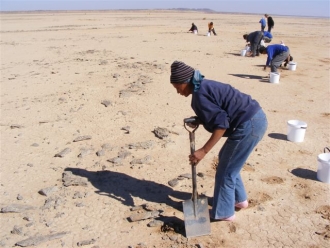 In mid-July we did a one day test on the pan with local workers, in order to determine how many square metres of pan one person can clear in one day. It was quite humorous when I briefed them in the morning: “Today we are going to drive to the middle of the pan, in an area where there are many rocks, and we are going to stand in a line and fill buckets with all the stones and rocks that come in your path and place them on piles at the end of the line and when we are done doing this for 8 hours we will leave them there”. They must have thought me completely mad.
In mid-July we did a one day test on the pan with local workers, in order to determine how many square metres of pan one person can clear in one day. It was quite humorous when I briefed them in the morning: “Today we are going to drive to the middle of the pan, in an area where there are many rocks, and we are going to stand in a line and fill buckets with all the stones and rocks that come in your path and place them on piles at the end of the line and when we are done doing this for 8 hours we will leave them there”. They must have thought me completely mad.
The test went very well, all be it at a much slower pace then we had anticipated. We successfully cleared, without exception, every single obstacle in our path and we gained valuable data in doing so. The best part was that it proved that, while it is labour-intensive, this is the most effective way to do the stone clearing without disrupting the rest of the pan’s surface. Sure, I agree, using mechanical brooms, or grading the pan or even importing a massive purpose built machine to remove the rocks mechanically would be much faster and maybe even cheaper, but the impact on the remainder of the pan in the removal process could be permanently damaging.
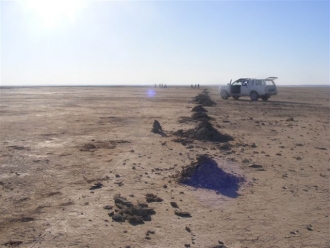 “How much did we clear?” you ask. Well we determined that, depending on the stone coverage, the average worker would clear between 60 sq m and 150 sq m per hour.
“How much did we clear?” you ask. Well we determined that, depending on the stone coverage, the average worker would clear between 60 sq m and 150 sq m per hour.
If all goes well, we will have a workforce of about 300 – 400 people working five days a week for about two months on the pan by next month (August). All the labour, equipment and logistics will be supplied by the Northern Cape government and the local municipality will employ the workers from the surrounding communities of Mier and Rietfontein, and unemployed persons will be given preference.
We will be able to clear approximately 60 soccer pitches per day and plan to concentrate on the main track this year in order to allow the rain (we hope it rains) to settle any surface disruption we caused. We will assess the status of the pan after the rainy season to determine if our method works well or needs improving, before continuing with the remainder of the track.
Soon the adventure will truly begin for us here in South Africa. I will keep you posted regularly as to our progress.
Rudi Riek, July 2010


